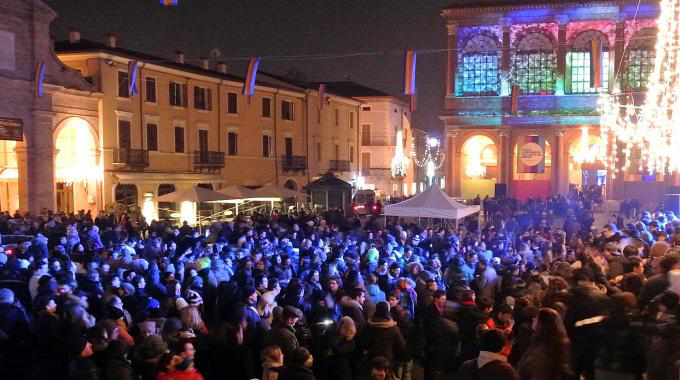Although ringing in the New Year on January 1st is a tradition that goes back for all of our lives, it has not always been the case in Italy. In ancient Rome, the calendar consisted of only ten months and the New Year began on March 1. There were 304 days in each year and the months were called Martius, Aprilis, Maius, Junius, Quintilis, Sextilis, September, October, November and December. The last six names were taken from the words for five, six, seven, eight, nine and ten. Romulus, the legendary first ruler of Rome, is reputed to have introduced this calendar in the 700s BC. The Romans seem to have ignored the remaining 61 days, which fell in the middle of winter.
It is traditional to ring in New Year’s with family and friends because the first people you see will either bring you good luck or bad. So make sure to keep friends close and your foes very far away. Italians are known for their lavish holiday celebrations and New Year’s is no exception. It is also no surprise that each region has its own unique way of ringing in the New Year.
For most Italians, the New Year’s Eve celebration begins with a large meal full of lentils and pork. Legumes, including beans, peas and lentils are symbolic of money. The round, flat, golden-brown appearance of some lentils is said to resemble gold coins. Romans used to give gifts of little satchels full of lentils as a way to wish the receiver wealth and well-being. In Italy, it’s customary to eat sausages and green lentils (cotechino con lenticchie), just after midnight—a particularly lucky meal because pork has its own lucky associations. Pig’s feet are associated with prosperity. People in Bologna and Modena eat lentils with zampone, the same sausage mixture stuffed into the skin of a pig’s foot. So, eat lentils with pork and plenty of money will come your way in the New Year.
Following the dinner, the party usually moves outdoors, where some cities set up concerts or bonfires in public squares. In Venice, large groups gather in San Marco Square and join together to make a massive group toast and everybody kisses at the stroke of midnight. While certain foods are intended to bring about luck and prosperity, there are also a number of foods to avoid. Although you may have had your fill of seafood during the Christmas Eve Feast of the Seven Fishes, you may want to stay away from lobster on New Year’s anyway. Since lobsters move backward, superstition says that this could lead to setbacks during the year. In the same vein, avoid chicken as well. Chickens scratch backwards, which could cause you regrets or dwelling on the past. In fact, to be on the safe side, avoid any winged fowl – you don’t want your good luck to fly away!
In Rome, festivities take place primarily around Piazza del Popolo where huge crowds enjoy live bands and dancing. The following day, the square fills again with a more child-orientated show with acrobats and mimes. There is also an outdoor classical music concert in the piazza facing the Quirinale about an hour before midnight, followed by fireworks at the stroke of midnight.
The celebration in Naples centers on the city’s magnificent fireworks display and also includes many musical events. Rimini, considered a hub of Italy’s club and nightlife scene, hosts a huge outdoor party in Piazzale Fellini. It features music, dancing, fireworks and is such a large party that it is shown on Italian television.
Wherever Italians call home and however they choose to celebrate, the most popular way to ring in the New Year is with fireworks. The roots of using fireworks, or more precisely, loud noises to ward off evil at midnight is an Italian custom that pre-dates everyone else’s use of fireworks. In Italy, it is believed that demons and evil spirts do not like loud noises so the fireworks were not so much about the beauty and grandeur, but making a lot of noise. Even the loud pops of Italian spumante and prosecco bottles are associated with warding off evil spirits and that’s why you’ll find them on each Italian table on New Year’s Eve.
Cities and towns throughout the country will have some kind of official fireworks display, but people often have their own private fireworks shows in squares, courtyards and parking lots. It can get very noisy but is always spectacularly gorgeous. While fireworks in the northern regions are a sight to behold, people in the southern regions, especially in Campania, claim theirs are the biggest, loudest and brightest of all. Some fireworks displays have become so popular that celebrants must stake out a place hours before nightfall, much as we do here in the U.S. prior to traditional holiday parades.
To many in Italy, it’s not New Year’s Eve unless a game of tombola is played. Just like bingo, tombola is one of those games every Italian American has played at least once in their lifetime. It may have been with your grandparents and there’s a very good chance that it was played on New Year’s Eve.
As for the New Year’s Eve toast, most Italians will pop the cork on a bottle of prosecco or spumante as they countdown from dieci to uno at the stroke of midnight. Visitors browsing through any of the Christmas markets or window shops in December may also notice a more prolific choice of red undergarments – an Italian tradition is to sport red mutande or undies on New Year’s Eve to ensure good fortune. Most Italians are aware of the tradition, but assume that the reason for the red undergarments are as a sign of passion, but it goes back to Roman times.
The color red was associated with war and bloodshed, but wearing red was a way of warding off the fear of battle. Therefore, wearing a red undergarment on New Year’s Eve symbolically helps to fend off evil and negative feelings, so that you may start the New Year off on the right foot!
There are a few rules that go along with this, the red undergarment must be brand new and has to come to you as a gift. If you buy it for yourself, you’re cheating. And you do not keep the underwear if you want the beneficial power to hold up against evil. As soon as you’ve finished the night’s celebrations – into the trash it goes!
If you are celebrating ‘alla Italiana’ in Italy this New Year’s Eve, make sure to stay away from open windows. Festivities call for “out with the old and in with the new.” The lancio dei cocci – literally means to launch shards; it is the custom of throwing your old dishware out of your living room window. This is likely to be the most Italian of all of the New Year’s traditions. As midnight rings, all of the past year’s negative feelings, spirts and bad luck are smashed symbolically through cups, dishes and saucers flying out the window.
New Year’s Eve celebrations carry on into New Year’s Day which is also known as capo d’anno, literally head of the year. In addition to La Festa di San Silvestro, New Year’s Eve is sometimes referred to as Notte di Capo d’Anno.
While many Italians spend New Year’s Day quietly, especially those who continued to ring in the New Year into the early morning hours, others find a number of events to enjoy. Ski resorts are packed with those who love winter sports and other cities and towns schedule parades and special events.
On January 1st in Rome, tens of thousands gather in St. Peter’s Square, filling the streets with pageantry and music to celebrate and receive the Pope’s New Year’s Day blessing. A focal point of Rome’s holiday season and the Pope’s Worldwide Day of Peace, the New Year’s Parade celebrates life and international good-will. The parade winds down the unusually wide Via della Conciliazione and ends in St. Peter’s Square. Participants include military, civic and school marching bands and auxiliary units and in keeping with Italian tradition, enthusiastic spectators may walk beside the bands, waving and whistling to show their appreciation. After parade participants crowd into the square, the Pope gives his annual New Year’s address and blessing. One of the most famous New Year’s Day traditions in Rome is the New Year’s Plunge when people from all over the world dive into the Tiber River from Rome’s Cavour Bridge.
In addition to the celebrations on New Year’s Day, there is another unusual practice that is followed throughout the country. It is cold in most of Italy and Italians do not like the cold! In spite of that, it is common practice to leave a door and at least one window open (two would be better) to allow the good spirits to enter your home; while the open windows create a draft that will clear out the bad spirits.





